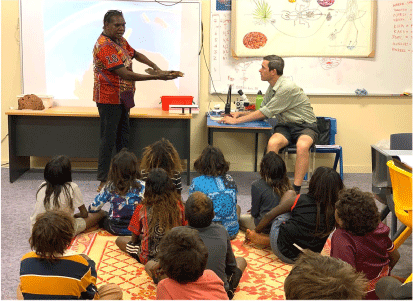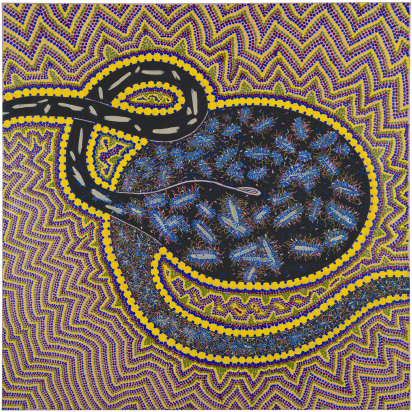Gurindji termite project
Gregory Crocetti and Briony BarrMicrobiology Australia 43(3) 142-143 https://doi.org/10.1071/MA22045
Submitted: 5 August 2022 Accepted: 5 August 2022 Published: 27 August 2022
© 2022 The Author(s) (or their employer(s)). Published by CSIRO Publishing on behalf of the ASM. This is an open access article distributed under the Creative Commons Attribution-NonCommercial-NoDerivatives 4.0 International License (CC BY-NC-ND)
Scale Free Network: art-science collective
Readers of Microbiology Australia might be aware of the Small Friends Books series, created by Scale Free Network with support from the Australian Society for Microbiology and published by CSIRO Publishing. The series was sparked by a series of conversations with Professor Linda Blackall in 2013, where we developed the idea to counteract common negative perceptions about microbes by creating stories that describe mutualistic partnerships between microbes and larger life forms. Together with Linda, writer Ailsa Wild and illustrator Aviva Reed, we created our first book, The Squid, the Vibrio & the Moon, about the symbiotic partnership between bobtail squid and bioluminescent Aliivibrio fischeri bacteria. This was followed by stories describing: microbial interactions within coral polyps (and what happens when coral bleaches); how some soil nematodes partner with bacteria to infect and kill insects; and how plants work together with networks of mycorrhizal fungi and bacteria to create a healthy soil environment around their roots. In each case, we collaborated with scientific experts to ensure scientific accuracy, as well as create an engaging story with beautiful artwork.
After releasing the fourth and final title in the Small Friends Books series in mid-2020, we turned our creative attention to symbiotic microbes living in the termite hindgut. Our interest in termite gut symbionts started where you might expect, with the protozoan Mixotricha paradoxa (first described by 1933 University of Melbourne researcher Jean L. Sutherland), and later beautifully depicted by Lynn Margulis and Dorion Sagan:
Scrutinizing any organism at the microscopic level is like moving ever closer to a pointillist painting by Georges Seurat: The seemingly solid figures of humans, dogs, and trees, on close inspection, turn out to be made up of innumerable tiny dots and dashes, each with its own attributes of colour, density, and form.
However, the exquisite Mixotricha (together with their endo- and ecto-symbionts) and their host Mastotermes darwiniensis were not to feature in our termite picture book. Because unlike our previous books – where we chose the symbiotic partnership and then collaborated closely with relevant (Western) scientific experts – with this project, we wanted to find different ways of working and collaborate with First Nations experts (particularly elders, rangers and artists), in the hope of drawing on and sharing their own ecological knowledge about termites, developed over millennia.
The first challenge was to find where this knowledge was still active. Over a period of several years, we kept a keen eye out for mention of termites in children’s books, contemporary literature or scientific articles and in early 2020 found the book, Karu: Growing up Gurindji (by Violet Wadrill, Biddy Wavehill Yamawurr, Topsy Dodd Ngarnjal and Felicity Meakins; Spinifex Press, 2019). The book describes the child-rearing practices of Gurindji women, which includes using termite mound (tamarra, roughly pronounced DAH-mar-ra) for a range of medicinal (bush medicine) reasons: ingested in a mix to treat diarrhoea; rubbed over mammary glands to promote lactation; or smothered over babies to help strengthen their blood, bones and spirit (particularly to help close the fontanelle; Fig. 1).

|
For some context: the Gurindji people are based in remote central-western Northern Territory, on the Northern edge of the Tanami desert. Gurindji elders led the Wave Hill Walk-Off in 1966 (protesting against mistreatment by the station managers), which helped to start Australia’s Land Rights movement. Kev Carmody and Paul Kelly captured elements of this story in their iconic song, From Little Things, Big Things Grow.
Through conversations with Professor Felicity Meakins (linguist with the School of Languages & Culture, UQ) and Penny Smith (manager of Karungkarni [Gurindji] Art & Culture Centre), we developed a broad approach to meet, listen and learn from local Gurindji elders, cultural custodians, rangers, artists and of course… termites. Through further conversations with Gurindji elders, Penny and Felicity refined the proposal and gained the necessary consent and permissions for our project to go ahead and we started planning the 5000 km drive up from Melbourne.
Upon arriving in Gurindji Country, we had a lot of questions: Which termites were most important? What was special about them? How would we work with Gurindji and other First Nations artists and knowledge keepers to create a collaborative methodology? What languages would the story be told in? Where would the story artwork come from?
Over the subsequent 4 months we delivered workshops across all year levels at the local school (in English and Gurindji Kriol; Fig. 2); went on several trips out onto Country with Gurindji elders and rangers; and collaborated with local artists to develop termite-inspired artwork. During our visits on Country with elders, we encountered a lot of spinifex (Triodia) grasses around the termite mounds preferred for use in Gurindji bush medicine. Close-up microscopy of these termites (with help from Professor Theo Evans, UWA) revealed them to be the Spinifex termite (Nasutitermes triodiae). Identifying this species of termite then led us into conversation with Professor Phil Hugenholtz, who had previously explored their gut microbiome at the Australian Centre for Ecogenomics (UQ), and helped us simplify the main digestive processes for the purposes of our picturebook.

|
Across this period, we were incredibly privileged to work closely with a large group of (mostly Gurindji) First Nation collaborators, including: artists and cultural custodians Violet Wadrill, Topsy Dodd and Leah Leaman; artists Lucy Tanami, Rosemary Johnson and Cecelia Edwards; and language worker Cassandra Algy. We were also fortunate to receive a grant from the Australia Council for the Arts to financially support our project, which also allows us to direct all of the future royalties from this book back to our Gurindji collaborators through the art centre.
The manuscript that emerged was written in a combination of Gurindji, Gurindji Kriol and English. The story was inspired by the web of ecological and cultural relationships around termites and termite mounds; from their symbiotic partnerships with gut bacteria and spinifex grasses (Fig. 3) to their connections to Gurindji people as a source of food and an important bush medicine. We are happy to report that our manuscript has just been accepted for publication by Hardie Grant, and is scheduled for release in July 2023.

|
Before our adventure, we understood the importance of openness and reciprocity in working with First Nations collaborators. However, through this journey, we learned a lot about putting these values into practice and about how incredibly important it is to first listen to and learn from people’s needs and wants…before trying to impose our ideas or agendas. These and other principles are explained in the recently published True Tracks: Respecting Indigenous knowledge and culture (UNSW Press), written by Meriam/Wuthathi lawyer Terri Janke – a fantastic resource to consult if you have the opportunity to work with First Nation people – with specific chapters covering scientific and research collaborations.


